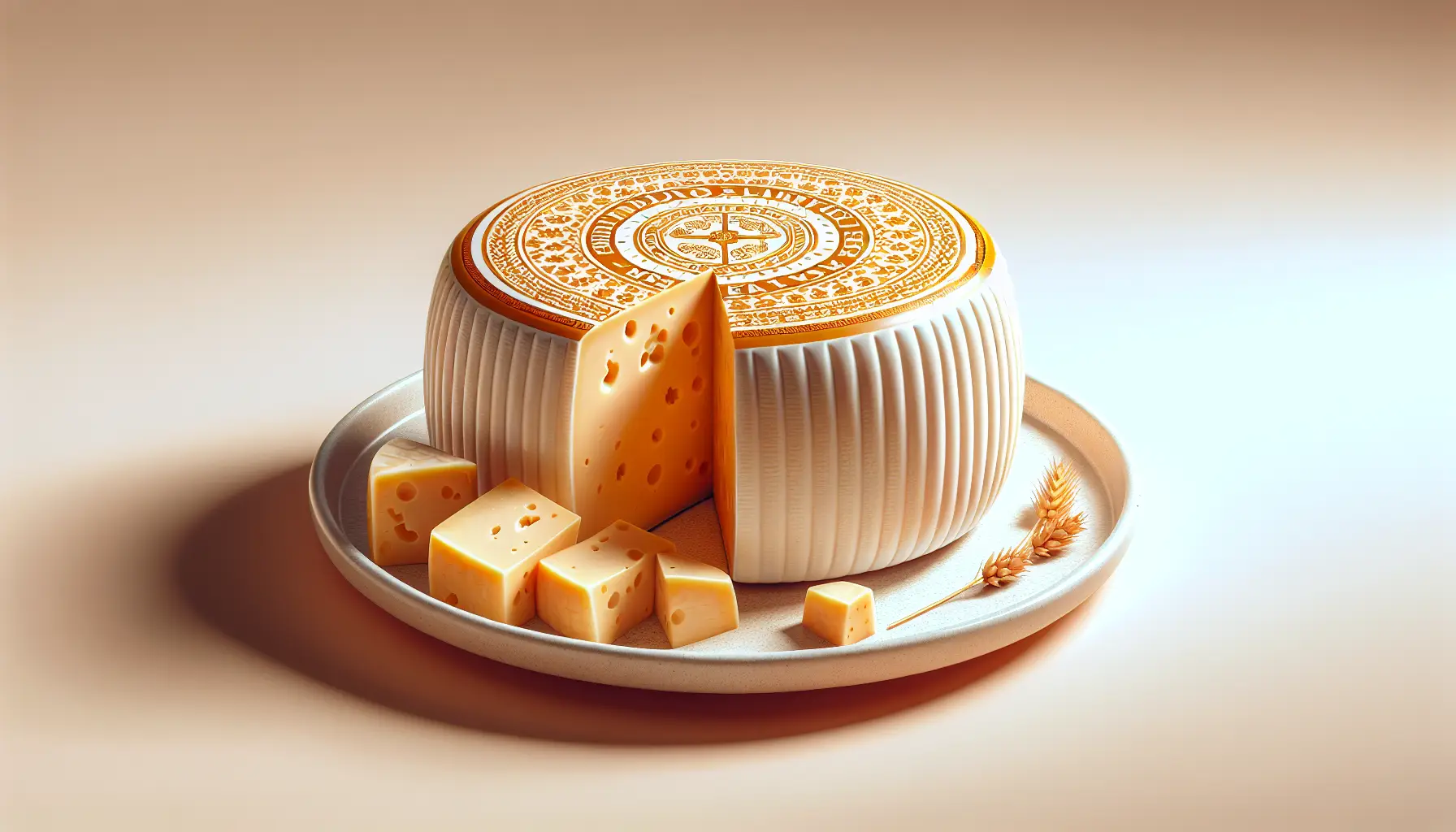Where Mahón Cheese Comes From
Mahón cheese is made exclusively on the island of Menorca in Spain. This small Balearic Island sits in the Mediterranean Sea and is known for its rocky coastline, sweet beaches, and ancient stone villages. It’s been a place of cheese-making for thousands of years.
The name “Mahón” comes from the port city of Maó-Mahón, the island’s capital city. For centuries, farmers and artisan cheesemakers have made cheese here using traditional methods, handed down from generation to generation. What makes Mahón cheese special is how it reflects the land it comes from, the salty sea air, local cow’s milk, and the use of hand-pressed cloths and wooden presses in maturing. These conditions help create the cheese’s signature flavour.
Mahón is one of the few Spanish cheeses with Protected Designation of Origin (PDO) status. This means there are very strict rules about where and how it must be made. That’s how you know you’re always getting the real deal.
What Mahón Cheese Tastes Like
One bite of Mahón cheese, and you’ll see why this cheese has such devoted fans. It has a creamy base, a firm but springy texture, and a bold, slightly salty flavour that builds as the cheese matures.
Younger Mahón, or Mahón fresco, is soft, mild, and milky, often eaten within weeks of making. It’s the kind of cheese you can slice thick and enjoy with crusty bread or melt over potatoes. As Mahón cheese ages, it turns deeper in flavour, nutty, and sharper. This aged type, known as Mahón curado, usually matures for six months or more and develops small holes inside the cheese, much like Emmental or Swiss cheese.
The cheese rind also changes as it ages. Cheesemakers often rub it with olive oil or paprika, not just for preservation but to help produce that eye-catching orangey-red colour and depth of flavour.
Whether mild or mature, Mahón cheese offers something exciting for every cheese lover. You can explore these varieties through our artisan cheeses collection.
How Mahón Cheese Is Made
Crafting Mahón cheese is a hands-on process passed down through local families. The milk comes mainly from Friesian or Menorcan cows on the island. Once collected, it’s carefully heated and mixed with rennet to begin the curdling process.
The curds are then placed in a cotton cloth known as a fogasser. Cheesemakers use cloths to help form the cheese into its iconic square pillow shape. From there, the cheese is gently pressed before being salted. Salt plays a huge role in giving Mahón its signature tangy finish, and traditionally, this salt came from Menorca’s seawater.
After its shaping, pressing, and salting, Mahón cheese is aged in caves or special cellars. Here, cheesemakers flip and rub the cheese regularly to help it mature evenly. Some wheels are aged for just a few weeks if they’re going to be eaten fresh, while others are aged for several months to develop sharper profiles.
At Cheese Shop Nantwich, we only stock real Mahón cheese made using traditional methods and packed with the authentic flavour of Menorca. Visit our Cheese Shop online to explore more.
Serving Suggestions That Bring Out the Best in Mahón
One of the things we love most about Mahón cheese is how flexible it is. It can work beautifully on a cheeseboard or be used in cooking to add warmth and character.
Try some ideas like:
- Sweet pairings: Add slices of Mahón to a cheeseboard with quince paste or fig jam. The saltiness of the cheese balances the sweetness.
- Pasta dishes: Grate aged Mahón over pasta or risotto for a nutty, bold topping.
- Grilled sandwiches: Use fresh Mahón in grilled cheese sandwiches with tomato; it melts smoothly.
- Baked potatoes: Mash some Mahón into hot baked potatoes with a dash of garlic for a Spanish twist.
- Wine pairings: Younger Mahón pairs well with white wines like Albariño, while aged Mahón goes better with red Rioja or sherry.
Mahón lends itself to both simple and gourmet dishes, making it one of the most enjoyable Spanish cheeses to keep in your fridge.
The Culture and Heritage Behind Mahón Cheese
One of the reasons we always recommend Mahón cheese is that it holds such strong cultural roots. In Menorca, cheese isn’t just a food, it’s part of everyday life, farming culture, and island festivals. Local cheesemakers, or formatgers, are passionate about making cheese using traditional skills. Generations of these families have kept age-old methods alive.
Many farms in Menorca still sell cheese from their dairies, often with slightly different flavours depending on the village soil, grass, and sea air. This rich backstory carries through every bite. It’s not just about cheese, it’s about love of the land and local pride.
By choosing Mahón cheese, you’re supporting artisan makers and keeping a piece of Menorcan tradition alive. That’s something we’re genuinely proud to share at Cheese Shop Nantwich.
Where You Can Buy Mahón Cheese in the UK
If you’re in the UK and wondering where you can get your hands on authentic Mahón cheese, we’ve made it simple for you. At Cheese Shop Nantwich, we stock a handpicked range of traditional artisan cheeses from across Europe, and Mahón is one of our shining stars.
We work closely with trusted suppliers who bring in Mahón straight from Menorca, so you always get high-quality cheese with the full Mediterranean flavour.
You can order online via our cheese shop and have it delivered fresh to your door, whether you’re in London, Manchester, or way out in the countryside.

FAQs
What milk is Mahón cheese made from?
Mahón cheese is made from cow’s milk, usually from Friesian cows that graze on Menorca’s rich pastures.
Is Mahón cheese vegetarian?
Traditional Mahón cheese typically uses animal rennet, but some producers may offer vegetarian-friendly versions. Always check the label or ask us at Cheese Shop Nantwich if you’re unsure.
How should I store Mahón cheese at home?
Wrap Mahón cheese in wax paper or parchment first, then cover it in a loose layer of foil or place it in a wooden or plastic cheese box. Keep it in the vegetable drawer of your fridge. This helps it breathe without drying out.
How do I know if Mahón cheese has gone off?
Mahón can develop surface mould over time, but this doesn’t always mean it’s gone bad. Just cut off the mouldy edge and check that it still smells rich and nutty, not sour or ammonia-like.
Is Mahón cheese similar to cheddar?
In texture and fat content, Mahón cheese can be similar to cheddar, especially the aged version. But the flavour profile is different, it’s creamier and saltier, with a Mediterranean flair.
Ready to Taste Mahón Cheese?
Trying Mahón cheese is like taking your taste buds on a little holiday to Spain. Whether you’re chewing into a milky young slice or savouring a bite of sharp aged Mahón, you’re enjoying a cheese shaped by sea air, sunshine, and heritage.
We at Cheese Shop Nantwich invite you to taste the bold and beautiful flavour of Mahón cheese. It’s perfect for sharing at dinners, picnics, or just enjoying with a glass of wine after a long day. Browse our site to explore artisan cheeses or stop by the cheese shop to pick your favourites.
Let this be your next culinary adventure, and bring a bit of Menorca into your kitchen.




